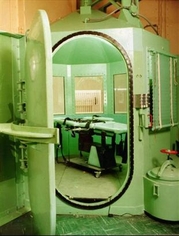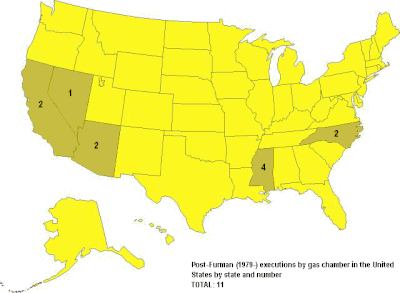Gas chamber (death penalty)

In some states of the USA were gas chambers for execution used by convicted criminals. There are currently no executions taking place in this manner, but some states reserve the right to use the method again. Gas chambers are also used by the Democratic People's Republic of Korea ( North Korea ). The use of gas chambers for executions is differentiated from the use for mass murder .
history
Most of the gas chambers date from the 1920s and 1930s. The gas chamber was first used on February 8, 1924 in Carson City , Nevada , USA, when the Chinese Gee Jon was executed there.
As of June 1, 1956, the Maryland gas chamber replaced slopes as a death penalty. The then governor Theodore McKeldin had recently signed a corresponding law. The first execution in Maryland was on June 29, 1957 on the death row inmate Eddie Lee Daniels.
On May 2, 1960, Caryl Chessman died in the gas chamber of San Quentin State Prison after his execution had been postponed eight times. As the gas rose, the phone rang. It was news that the execution would be postponed for the ninth time. However, the chief officer chose to continue because the execution was too far advanced to stop.
Until the US-wide enforcement moratorium, which began in the summer of 1967 and ended in early 1977, the gas chamber was the designated method of execution in eleven states. Meanwhile, six of them ( Colorado , Mississippi , Nevada , New Mexico , North Carolina , Oregon ) have switched to lethal injection as the only method.
In addition to lethal syringes, the gas chamber is currently still approved in five states, although different regulations apply here. In California , the convict can choose between injection and gas death. In Arizona , before November 15, 1992, convicts can choose between syringe and gas; syringes are compulsory for later convicts. A similar rule exists in Maryland , where offenders can vote who have committed their death sentence prior to March 25, 1994. For everyone else, however, lethal injection is required. In Missouri , both types of execution coexist, although the law does not explicitly state whether the condemned person or the state authorities determine the method in each individual case. In Wyoming , the gas chamber is only provided in the event that courts should declare lethal injection unconstitutional.
After the resumption of executions since 1977, a total of eleven people in five states (see map) were executed using gas. The first to be executed after the resumption of the death penalty, and so far the only one in Nevada to die in a gas chamber, was 66-year-old Jesse Bishop. The last person to be executed in a gas chamber in the USA on March 3, 1999 was the German Walter LaGrand in the state of Arizona, convicted of murder . He could choose between lethal injection and gas and had chosen the gas chamber. The International Court of Justice ruled in 2001 that this execution, which was carried out despite an interim order from the ICJ, was contrary to international law.
Since April 2015, gasification with nitrogen (N 2 ) has been planned in Oklahoma when poison injection is not possible. So far, however, it has not been used.
Course of execution in the United States
The gas chambers of the USA are octagonal steel chambers with a diameter of almost three meters.
The convict is strapped to a chair inside the chamber. The upper part is glazed so that the witnesses prescribed for the execution of the sentence can watch the execution. The gas-tight door is then closed from the outside. By actuating a lever, a chemical reaction of two components - sulfuric acid and potassium cyanide (cyanide) - is triggered under the condemned person's seat . The potassium cyanide falls into an open acid container, which creates the poisonous hydrogen cyanide gas ( hydrogen cyanide ) and allows it to spread. Official and summoned witnesses must watch the entire execution process.
After the execution, the executed man remains in the gas chamber for about half an hour before the gas is sucked out and fresh air is let into the room. The remaining chemicals are diluted with water and pumped into the sewer system. The chamber is then opened. The room and the body need to be sprayed with ammonia . Because even now, touching the poison that has been adsorbed in the clothes and on the skin of the condemned person is life-threatening. Then a doctor officially declares death. The dead person is given to the undertaker in a special plastic bag. This plastic bag must no longer be opened, as the undertaker would otherwise expose himself to potentially fatal poisoning (due to desorption ).
Usage in North Korea
The Haengyŏng Concentration Camp (also known as Camp 22 ) has a gas chamber in which those sentenced to death are gassed. Scientists can observe the gassings through a pane of glass that is attached above the gas chamber. Whole families were gassed together, according to the former military attaché at the North Korean Embassy in Beijing . The gas chamber is 3.5 meters wide, 3 meters long and 2.2 meters high. In the Boston Globe the gassings in North Korea were compared with those in Auschwitz , which was also discussed in the US Congress .
effect
The hydrogen cyanide gas (HCN) is inhaled; it is distributed to all cells in the body by the bloodstream and prevents the cells from breathing, causing cramps after approx. 60 seconds. The lack of energy ( adenosine triphosphate deficiency) in the body cells leads to unconsciousness and then to death. The death row inmates usually lose consciousness after 15 seconds to a minute, and the onset of convulsions is no longer consciously noticed. If the death row inmate does not take a deep breath immediately (as recommended), however, the poison causes the breathing apparatus to fail faster than consciousness, which leads to excruciating complications. In not infrequent cases, a side effect occurs that the prisoner's consciousness and thus the pain sensation are retained for a few minutes and the prisoner suffers severe pain, which can be comparable to death by suffocation. As further complications, very painful cramps or high levels of adrenaline and lactic acid can occur.
Web links
- Death penalty by means of a gas chamber
- Execution with gas with further references
Individual evidence
- ↑ Robert M. Bohm: Death Quest: An Introduction to the Theory and Practice of Capital Punishment in the United States . 4th edition, Elsevier 2011, ISBN 1-4377-3499-5 , p. 135 ( limited preview in the Google book search).
- ↑ http://articles.baltimoresun.com/1993-11-02/news/1993306212_1_gas-chamber-new-chamber-thanos Baltimore Sun on November 2, 1993: "A 'neater' way to kill"; Introduction of the gas chamber in Maryland; accessed on May 7, 2018
- ↑ Peter Maxwill: Caryl Chessman: The man who died nine times. Article on one day of June 24, 2013, last viewed January 9, 2014.
- ↑ Death Penalty Information Center (select "Methods": "Gas Chamber", then "Search by Details")
- ↑ LAGRAND CASE (GERMANY v. UNITED STATES OF AMERICA) (MERITS). IGH, June 27, 2001, accessed December 21, 2018 .
- ↑ Oklahoma Gov. Mary Fallin signs bill allowing nitrogen asphyxiation as alternative execution method. In: NewsOK.com. Retrieved March 29, 2016 (American English).
- ↑ Yad Vashem Reacts to Gas Chambers in North Korea. Yad Vashem, accessed March 29, 2016 .
- ^ Antony Barnett: Revealed: the gas chamber horror of North Korea's gulag . In: The Guardian . January 31, 2004 ( theguardian.com [accessed March 29, 2016]).
- ↑ Olenka Frenkiel: 'I saw an entire family being killed. They were put in the gas chamber where they were all suffocated. The last to die was the youngest son '. In: Telegraph.co.uk. Retrieved March 29, 2016 .
- ^ This World North Korea. In: bbc.co.uk. Retrieved March 29, 2016 .
- ^ Congressional Record: Proceedings and Debates of the 111th Congress First Session: Vol. 155 Part 8 . Government Printing Office ( google.de [accessed on March 29, 2016]).
- ↑ to the various effects of cyanide poisoning in chronological order in the Abtlg. Time factor in online guides "cyanide poisoning and smoke" the company Merck Serono .
- ↑ Bernd Engels, Carsten jewelry, Reinhold Fink, Tanja Schirmeister: Chemistry for medical professionals . Online Ressource, Pearson Germany, Munich 2008, ISBN 3-8273-7286-0 , p. 341 ( limited preview in the Google book search).
- ^ William Schabas: The Death Penalty as Cruel Treatment and Torture. P. 193.

